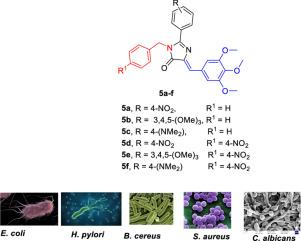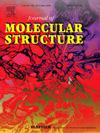Design, microwave synthesis, characterization and antimicrobial activity of imidazolone derivatives
IF 4
2区 化学
Q2 CHEMISTRY, PHYSICAL
引用次数: 0
Abstract
Overuse and misuse of antibiotics create superbugs as drug-resistant bacteria. The vital strategy is developing new antibiotics, and one of the vital compounds that proved activity as antimicrobials is imidazoles. So, we designed and synthesized a series of imidazolones via microwave radiation in excellent yield and evaluated them as antimicrobial agents with docking studies to promote and boost their activity. The results obtained from spectroscopic analyses approved the chemical structures of new compounds. The biological antimicrobial activity results was found that these compounds exert an excellent broad spectrum antimicrobial activity against many Gram-positive and Gram-negative bacteria, as well as different fungal strain including some highly human pathogenic microorganisms.
Compounds 5a-5c are active against Gram-positive bacteria and compounds 5d-5f against Gram-negative bacteria, together with Candida albicans as fungi. Molecular Docking study on the active compounds 5e, 5f showed ring-stacking interactions between them as ligands and related proteins, which are compatible with other results. Gaussian 09 program is used as computational chemistry software to confirm the obtained experimental results.

咪唑啉酮衍生物的设计、微波合成、表征和抗菌活性
过度使用和滥用抗生素会产生超级细菌,即耐药性细菌。重要的策略是开发新的抗生素,而咪唑类化合物是被证明具有抗菌活性的重要化合物之一。因此,我们通过微波辐射设计并合成了一系列咪唑类化合物,产量极高,并通过对接研究将其作为抗菌剂进行了评估,以促进和提高其活性。光谱分析结果证实了新化合物的化学结构。生物抗菌活性结果表明,这些化合物对多种革兰氏阳性和革兰氏阴性细菌以及不同的真菌菌株(包括一些人类高致病性微生物)具有极好的广谱抗菌活性。化合物 5a-5c 对革兰氏阳性细菌具有活性,化合物 5d-5f 对革兰氏阴性细菌以及白色念珠菌等真菌具有活性。对活性化合物 5e、5f 进行的分子对接研究显示,它们作为配体与相关蛋白质之间存在环状堆积相互作用,这与其他结果相符。计算化学软件 Gaussian 09 被用来证实所获得的实验结果。
本文章由计算机程序翻译,如有差异,请以英文原文为准。
求助全文
约1分钟内获得全文
求助全文
来源期刊

Journal of Molecular Structure
化学-物理化学
CiteScore
7.10
自引率
15.80%
发文量
2384
审稿时长
45 days
期刊介绍:
The Journal of Molecular Structure is dedicated to the publication of full-length articles and review papers, providing important new structural information on all types of chemical species including:
• Stable and unstable molecules in all types of environments (vapour, molecular beam, liquid, solution, liquid crystal, solid state, matrix-isolated, surface-absorbed etc.)
• Chemical intermediates
• Molecules in excited states
• Biological molecules
• Polymers.
The methods used may include any combination of spectroscopic and non-spectroscopic techniques, for example:
• Infrared spectroscopy (mid, far, near)
• Raman spectroscopy and non-linear Raman methods (CARS, etc.)
• Electronic absorption spectroscopy
• Optical rotatory dispersion and circular dichroism
• Fluorescence and phosphorescence techniques
• Electron spectroscopies (PES, XPS), EXAFS, etc.
• Microwave spectroscopy
• Electron diffraction
• NMR and ESR spectroscopies
• Mössbauer spectroscopy
• X-ray crystallography
• Charge Density Analyses
• Computational Studies (supplementing experimental methods)
We encourage publications combining theoretical and experimental approaches. The structural insights gained by the studies should be correlated with the properties, activity and/ or reactivity of the molecule under investigation and the relevance of this molecule and its implications should be discussed.
 求助内容:
求助内容: 应助结果提醒方式:
应助结果提醒方式:


